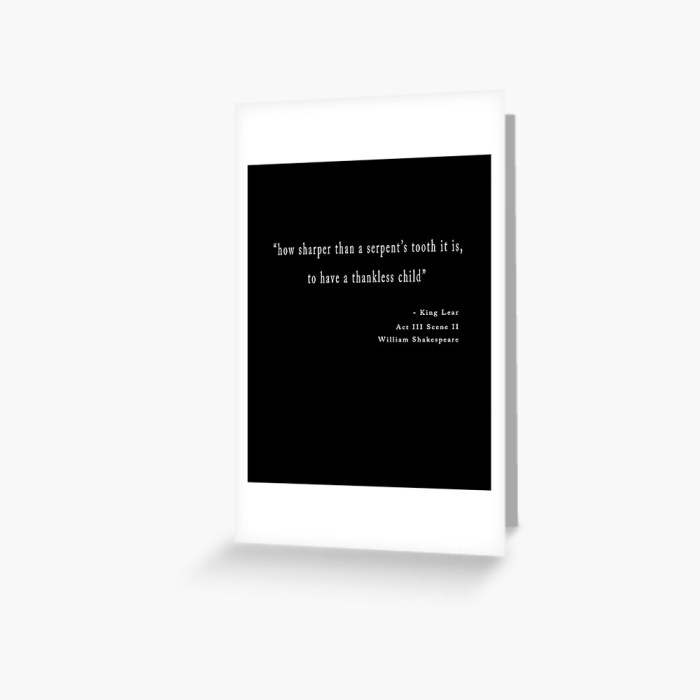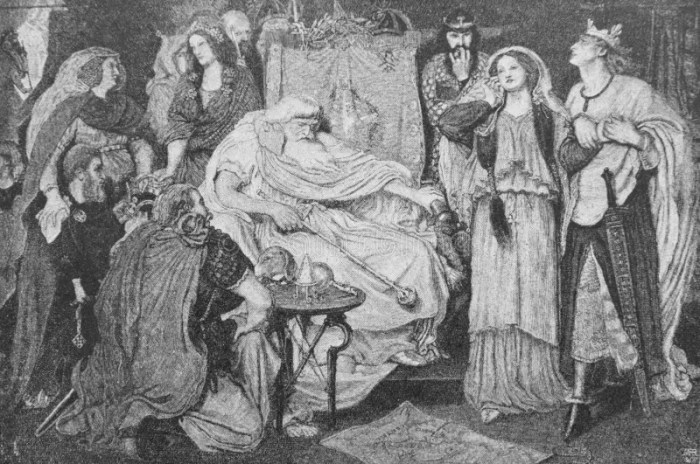Lear curses a thankless child – Lear’s Curse: A Thankless Child, a powerful scene from Shakespeare’s iconic play “King Lear,” unravels a compelling narrative of ingratitude, betrayal, and the consequences of parental wrath. As the story unfolds, we witness the tragic downfall of a king who, blinded by pride and vanity, banishes his loyal daughter Cordelia, only to face the bitter sting of betrayal and abandonment.
Through the use of vivid imagery, symbolism, and masterful characterization, Shakespeare explores the profound themes of filial piety, the complexities of familial relationships, and the devastating power of unchecked anger.
Literary Analysis of “Lear Curses a Thankless Child”

Shakespeare’s “Lear Curses a Thankless Child” is a powerful and tragic tale that explores the devastating consequences of ingratitude, betrayal, and parental wrath. The curse, uttered by the aging King Lear in a fit of rage, becomes a catalyst for a series of events that ultimately lead to the downfall of both Lear and his ungrateful daughters, Goneril and Regan.
Themes of Ingratitude and Betrayal
The theme of ingratitude is central to the play. Lear’s daughters, Goneril and Regan, are initially portrayed as loving and devoted, but their true nature is revealed when Lear divides his kingdom among them. Goneril and Regan, driven by greed and ambition, turn against their father, casting him out into the storm and stripping him of his power.
“Ingratitude! Thou marble-hearted fiend,More hideous when thou show’st thee in a child Than the sea-monster!”
The theme of betrayal is also closely intertwined with ingratitude. Goneril and Regan’s actions not only demonstrate their lack of gratitude but also a deep betrayal of the trust and love that their father has placed in them. Their betrayal sets in motion a chain of events that ultimately leads to the destruction of the entire family.
Consequences of Parental Wrath
The curse that Lear utters in response to his daughters’ betrayal is a manifestation of his immense anger and despair. The curse, which calls down upon Goneril and Regan a series of horrors, including barrenness, madness, and death, serves as a warning of the dire consequences of parental wrath.
However, the curse also reveals Lear’s own flaws. His pride and rashness lead him to make decisions that ultimately contribute to his downfall. The curse becomes a symbol of the destructive power of uncontrolled anger and the importance of forgiveness and reconciliation.
Dramatic Techniques in the Scene

The scene between Lear and Goneril in Act 1, Scene 4 of King Lear is a powerful and dramatic moment in the play. Shakespeare employs a range of dramatic techniques to create a scene that is both emotionally charged and thematically significant.
Imagery and Symbolism
Shakespeare uses vivid imagery and symbolism throughout the scene to create a sense of chaos and disorder. The storm that rages outside the castle reflects the turmoil within Lear’s mind and the kingdom. The images of the “unaccommodated man” and the “bare forked animal” suggest that Lear is stripped of his power and dignity, and is reduced to a state of primal instinct.
Characters’ Motivations and Relationships
The scene also reveals the complex motivations and relationships between the characters. Lear’s anger and frustration with Goneril stem from her ingratitude and disrespect. Goneril, on the other hand, is motivated by a desire for power and control. Her refusal to provide Lear with shelter and food shows her lack of compassion and her willingness to betray her father.
Shakespeare’s play “King Lear” depicts the tragedy of a king who curses his thankless child, a poignant tale that explores themes of betrayal and familial strife. For those seeking to delve deeper into the psychological aspects of such relationships, I recommend exploring the comprehensive unit 7 ap psychology vocab . This resource provides valuable insights into the dynamics of parent-child relationships and the potential consequences of parental rejection.
Impact on the Overall Narrative, Lear curses a thankless child
The scene between Lear and Goneril is a turning point in the play. It marks the beginning of Lear’s descent into madness and the disintegration of his kingdom. The scene also foreshadows the tragic events that will follow, as Lear’s actions and decisions lead to the destruction of himself and his family.
Cultural and Historical Context

During Shakespeare’s time, filial piety was a deeply ingrained societal norm. Children were expected to show utmost respect and obedience to their parents, regardless of their circumstances. This expectation was rooted in the Confucian values that permeated East Asian societies, including England during the Renaissance period.
Influence of Classical Mythology
Shakespeare’s play also draws heavily on classical mythology, particularly the story of Oedipus Rex. In the Greek myth, Oedipus curses his son, Polynices, for disobeying him. This curse serves as a cautionary tale about the dire consequences of defying parental authority.
In “Lear Curses a Thankless Child,” Lear’s curse upon Goneril and Regan reflects the cultural values of the period, which emphasized the importance of filial piety and the dire consequences of disobeying one’s parents.
Performance Considerations

Performing the scene from “Lear Curses a Thankless Child” presents both challenges and opportunities for actors. The scene’s emotional intensity requires performers to convey the characters’ complex emotions through voice, gesture, and facial expressions.
Voice
The actors’ voices must effectively convey the characters’ emotions, from Lear’s rage and despair to Goneril’s cold indifference. Actors must control their volume, pitch, and intonation to express the characters’ inner turmoil and the tension between them.
Gesture
Gestures play a vital role in conveying the characters’ physical and emotional states. Lear’s violent hand gestures and stamping feet reflect his anger and frustration, while Goneril’s stiff and calculated movements emphasize her emotional detachment.
Facial Expressions
Facial expressions are crucial for conveying the characters’ unspoken thoughts and emotions. Lear’s contorted face and teary eyes reveal his pain and vulnerability, while Goneril’s impassive expression masks her true feelings.
Interpretations
Different interpretations of the scene can significantly impact its meaning. Some productions emphasize Lear’s descent into madness, while others focus on the generational conflict between father and daughter. Actors’ choices in performance can shape the audience’s understanding of the characters and their relationships.
FAQs
What is the significance of the curse in the play?
The curse serves as a pivotal moment in the play, marking the point of no return for Lear. It reveals the depth of his anger and pride, and sets in motion a chain of events that ultimately lead to his downfall.
How does the scene explore the theme of ingratitude?
The scene powerfully depicts the devastating consequences of ingratitude. Lear’s daughters, Goneril and Regan, betray his trust and show no remorse for their actions, highlighting the corrosive effects of a lack of gratitude.
What are the challenges for actors in performing this scene?
Actors must convey the complex emotions of the characters, including Lear’s rage, Cordelia’s love, and the manipulative nature of Goneril and Regan. The scene requires a nuanced understanding of the characters and their motivations.

